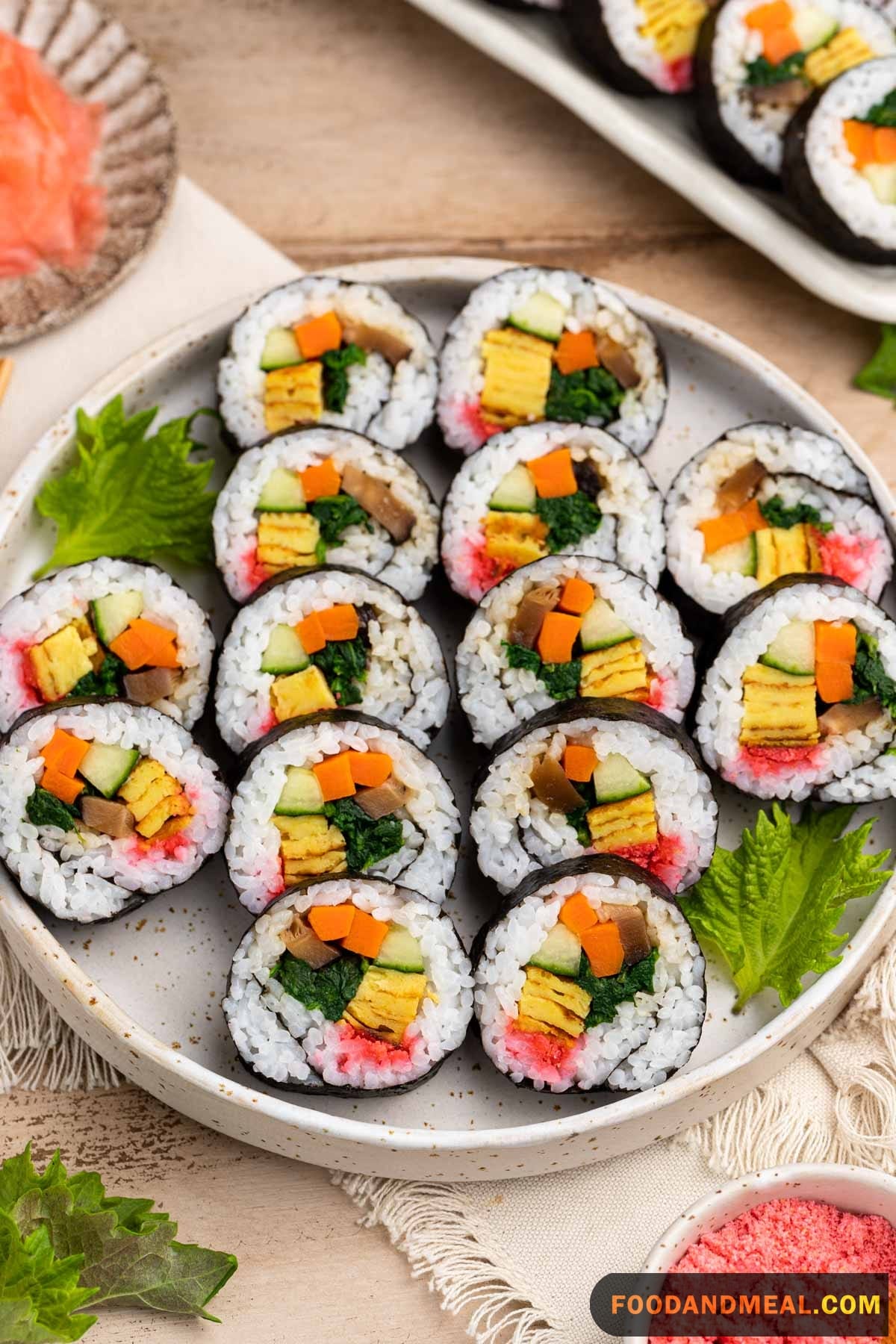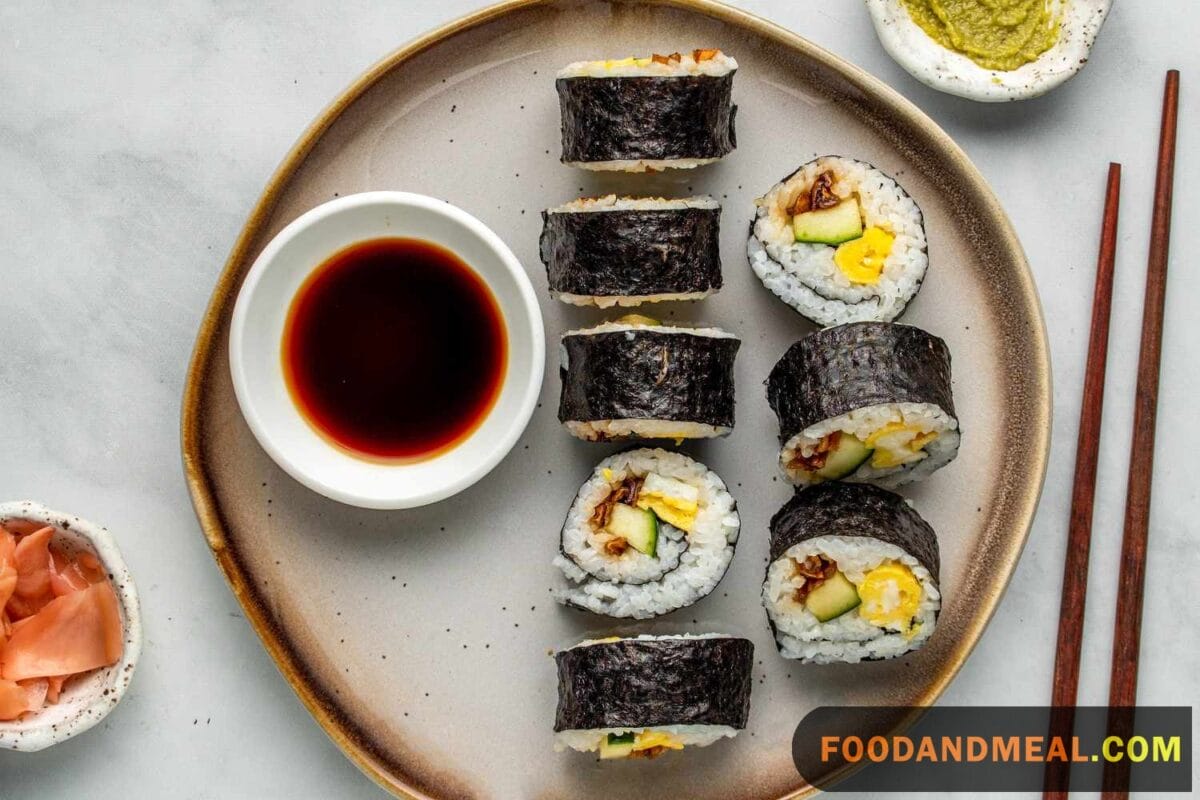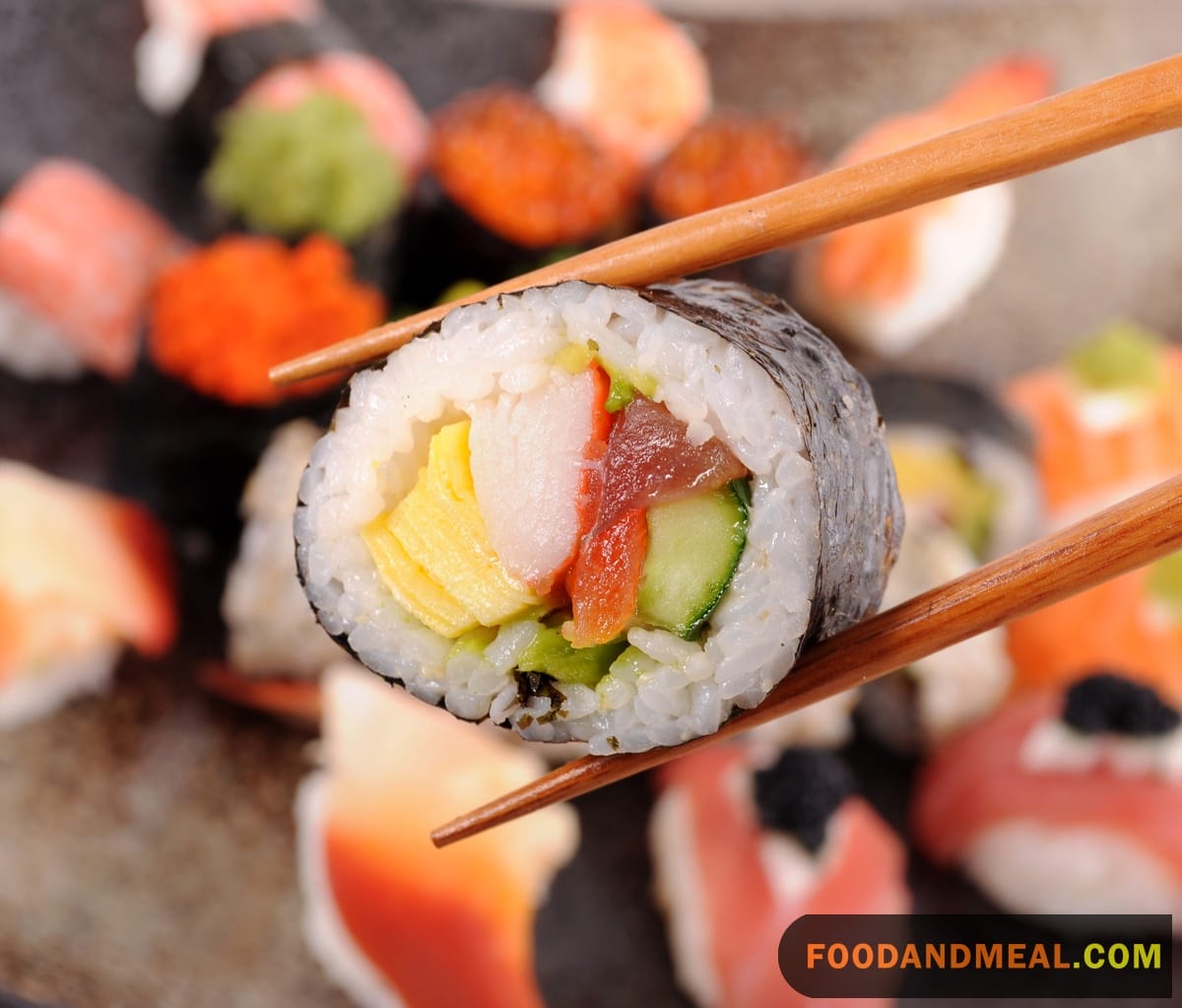Futomaki is a Japanese sushi roll that is traditionally eaten with chopsticks. The rolls are made from rice, vegetables, and meat, but some versions are made entirely of vegetables, while others include seafood or unagi. Served during the traditional holiday of Setsubun, futomaki is believed to bring good health and prosperity. To add to the flavors, you can add additional meat or vegetables. You can even add pickled cucumbers or other ingredients to make the sushi even more tasty.
Futomaki – Thick Sushi Roll Recipes


Futomaki - Thick Sushi Roll
Equipment
Ingredients
- 3 sheets nori
- 15-20 large shrimp cooked
- 3 pieces imitation crab sticks halved lengthwise
- ⅓ cup carrot finely grated
- 1 small Japanese cucumber cut into strips
- 1 avocado pitted, peeled, cut into strips
- 2 leaves romaine lettuce shredded
- 4 cups cooked rice seasoned with sushi vinegar
- ¼ cup rice vinegar
- Wasabi as condiments
- soy sauce as condiments
- sushi ginger gari, as condiments
Sushi rice
- 3 cups sushi rice shari
- 4 ¼ cups sushi vinegar
Sushi vinegar
- 3 ½ cups water
- ½ cup rice vinegar do not use any other vinegar
- 2 tablespoons white sugar
- 2 teaspoons refined salt
Vinegar water for dipping hands ( Tezu )
- ¼ cup water
- 2 teaspoon rice vinegar
Instructions
For sushi vinegar
- Combine all the sushi vinegar ingredients in a saucepan and warm it on the stovetop over medium heat. Stir until the well dissolved. (You may also heat the vinegar solution in the microwave.)
- Put the rice in a fine-mesh strainer and wash under cold running water until the rinsing water runs clear. Drain well.
Sushi Rice - on the stovetop
- Place the rice in a heavy-bottomed pot and add the water. Make sure the rice surface is level. Bring it to a boil, reduce the heat to low, and cover the pot. f the boiling liquid overflows, remove the lid for it to go down and replace the lid immediately. Allow the rice to absorb all the water. Watch out for scorching. If you smell the rice burning, immediately remove it from the heat and allow it to cook in residual heat. The rice is done when all water has been absorbed.
Sushi rice - using a rice cooker
- Place the washed rice grains in the rice cooker pot and add the 3 1 cups of water. Cook according to the rice cooker’s instructions (usually you just press the “cook” button).
- Transfer the cooked rice to a hangiri, or a large mixing bowl, and place it in the refrigerator to cool. At this stage, fillers can be prepared while waiting for the rice to cool down.
- Make sure the rice is completely cool, as the center may still be hot.
- Pour the vinegar mixture over the rice and mix it into the rice with your hands.
To make the roll
- As you will make 3 rolls, divide all the ingredients into 3.
- Follow the steps for making sushi.
- In placing the filling: Arrange 5-6 shrimp in a row about 2" from the close edge. Add a row of sea sticks, then a row of shredded lettuce. On top of the shrimp, place slices of avocado and shredded, stacked like logs of wood.
- Cut each roll into 8 slices. Serve with soy sauce, wasabi, and pickled ginger.
Video
Notes
Nutrition
© Food And Meal
This website provides approximate nutrition information for convenience and as a courtesy only. Nutrition data is gathered primarily from the Spoonacular Database, whenever available, or otherwise other online calculators.
Alternative Method: Futomaki in a Rice Cooker

Ingredients:
- Sushi rice
- Nori (seaweed) sheets
- Assorted fillings (e.g., cooked and seasoned vegetables, crab sticks, avocado, cucumber, and omelet)
- Rice vinegar
- Sugar
- Salt
- Soy sauce
- Pickled ginger, wasabi, and soy sauce for serving
Instructions:
- Prepare the Rice:
- Rinse the sushi rice under cold water until the water runs clear.
- In the rice cooker, add the rinsed rice and the appropriate amount of water as per your rice cooker’s instructions.
- Cook the Rice:
- Start the rice cooker, and let it cook the rice. Most modern rice cookers have a built-in sensor to ensure perfectly cooked rice.
- Season the Rice:
- In a small bowl, mix rice vinegar, sugar, and a pinch of salt. The exact measurements depend on the quantity of rice; a common ratio is 1:4:1 (rice vinegar:sugar:salt).
- When the rice is done, transfer it to a large, non-metallic bowl while it’s still warm.
- Gradually add the vinegar mixture to the rice while gently folding it in. Be cautious not to break the rice grains. Allow the rice to cool to room temperature.
- Prepare the Nori Sheets:
- Cut the nori sheets in half using kitchen scissors.
- Roll the Futomaki:
- Lay a bamboo sushi rolling mat on a clean surface and cover it with plastic wrap.
- Place a half-sheet of nori on the mat, shiny side down.
- Wet your fingers to prevent the rice from sticking and evenly spread a layer of seasoned rice over the nori, leaving a small border along the top edge.
- Add Fillings:
- Arrange your choice of fillings in a horizontal line along the center of the rice.
- Roll It Up:
- Lift the bamboo mat’s edge closest to you, and start rolling the nori and rice over the fillings. Apply gentle pressure to shape the roll.
- Slice and Serve:
- Use a sharp knife dipped in water to slice the Futomaki into bite-sized pieces.
- Enjoy:
- Serve your homemade Futomaki with pickled ginger, wasabi, and soy sauce.
Tips for making Futomaki

Cooking Tips
- Rice is Key: Use high-quality sushi rice. It should be short-grain and have the right balance of stickiness and fluffiness.
- Season the Rice Right: When seasoning the rice with vinegar, sugar, and salt, ensure the rice is still warm for better absorption of flavors.
- Sharp Knives are Essential: A sharp, wet knife is crucial for clean and beautiful slices. Dip it in water frequently to prevent sticking.
- Wet Your Hands: Keep a bowl of water handy to wet your fingers when working with the rice. This prevents the rice from sticking to your hands.
- Use a Bamboo Mat: When rolling, a bamboo sushi mat covered in plastic wrap helps maintain the proper shape and firmness.
- Experiment with Fillings: Get creative with your fillings. Traditional choices include vegetables, crab sticks, avocado, cucumber, and omelet, but feel free to explore your favorites.
Serving Suggestions

- Serve with Miso Soup: A classic pairing, a bowl of miso soup on the side complements the flavors and completes your Japanese meal.
- Pickled Ginger and Wasabi: Serve pickled ginger and wasabi alongside your Futomaki. These condiments add a delightful zing to each bite.
- A Side of Tempura: Tempura vegetables or shrimp make an excellent side dish, offering a delightful contrast in texture.
- Fresh Sashimi: Elevate your meal with a selection of fresh sashimi slices, such as tuna or salmon.
- Pair with Green Tea: A steaming cup of green tea is a perfect beverage to accompany your Futomaki.
FAQs (Frequently Asked Questions) about Futomaki

- Can I make Futomaki in advance for a party or gathering? Yes, you can prepare Futomaki in advance and store it in the refrigerator. Just be sure to wrap it tightly in plastic wrap to prevent it from drying out.
- What if I can’t find sushi rice? While sushi rice is ideal, you can use short-grain or medium-grain rice as a substitute.
- Are there vegetarian Futomaki options? Absolutely! You can create delicious vegetarian Futomaki using a variety of vegetables and tofu.
- Can I freeze leftover Futomaki? It’s best to consume Futomaki fresh. Freezing can alter the texture of the rice and fillings.
- Is there a particular way to eat Futomaki? Enjoy it your way! Some prefer to dip each piece in soy sauce, while others like to savor it as is. There are no strict rules.
Craft Futomaki Sushi at Home – Perfect for Beginners: Experience the joy of making Futomaki with our easy-to-follow recipe. Subscribe to stay updated on culinary adventures.
I'm James F Anderson, a noted sous chef from London and a Le Cordon Bleu alumnus. My career began in a Michelin-starred Parisian eatery, where my blend of classic and contemporary cooking, using seasonal ingredients, earned accolades. Recognized in culinary publications and on cooking shows, I’m committed to mentoring aspiring chefs and delivering memorable dining experiences, marking me as a standout talent in the culinary world.



